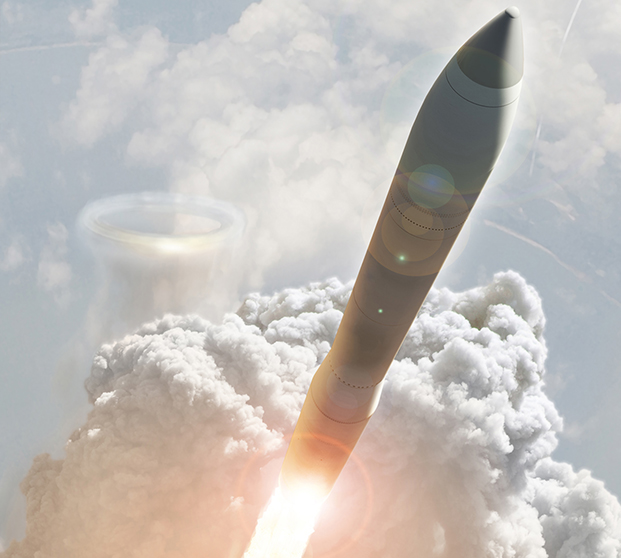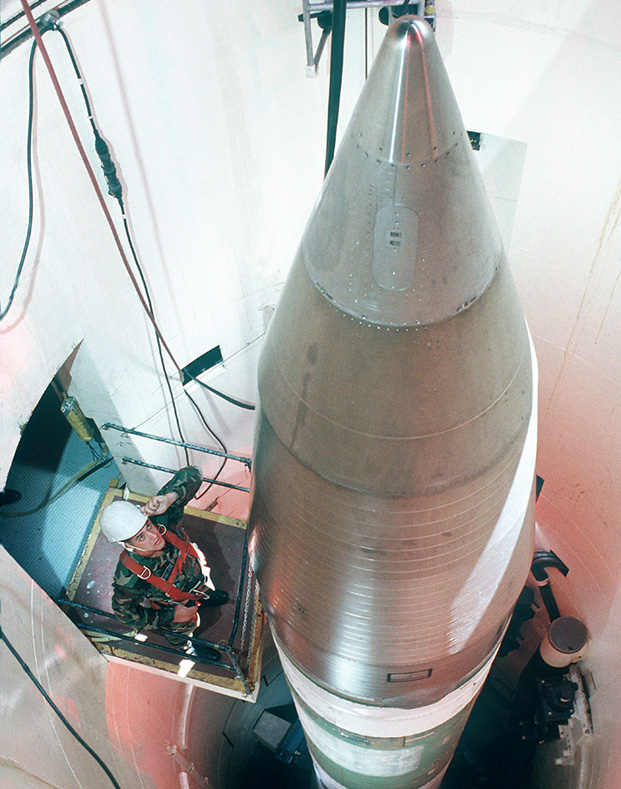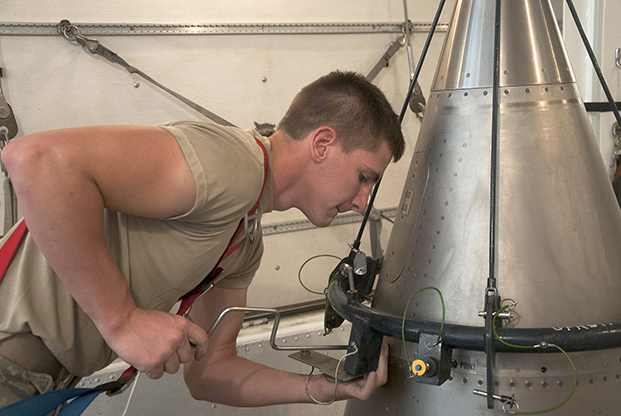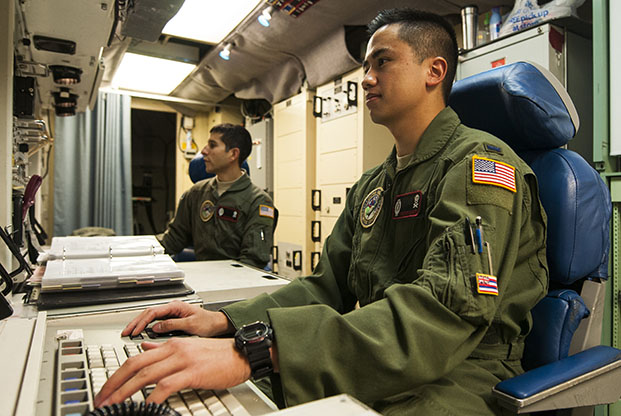
An artist’s illustration of Boeing’s proposed Ground Based Strategic Deterrent missile, intended to replace USAF’s Minuteman III ICBMs. Boeing illustration
The Air Force’s effort to field a next generation intercontinental ballistic missile (ICBM) system has renewed energy, as the service announced in August the award of two contracts for technology maturation and risk reduction (TMRR)work.
The contracts, to Boeing and Northrop Grumman, pave the way for replacing the Minuteman III with what is being called the Ground-Based Strategic Deterrent (GBSD). One of the two will be chosen in 2020 to build the system, and the service’s Nuclear Weapons Center at Kirtland AFB, N.M., is working hard to keep the program on time and within budget.
It’s a tough challenge, since the next ICBM needs to last until 2075 and must be able to adapt to decades’ worth of evolving threats. Success will require a smart acquisition strategy and intelligent system design.
The Minuteman III replacement program hasn’t always enjoyed this kind of momentum. Within the bow wave of modernization programs the Air Force is funding—a large slate of new fighters, bombers, space systems, and surveillance platforms—recapitalizing nuclear ICBM and bomber weapon systems has repeatedly been delayed or deferred.
The new ICBM system will be very expensive. Replacing Minuteman alone could cost as much as $85 billion for research and development, procurement, and military construction. With budget shortfalls pressing the Department of Defense from every direction, upgrading the nation’s nuclear weapons is “the one place where we can save money the most clearly,” said Rep. Adam Smith (D-Wash.), the ranking member of the House Armed Services Committee, in July.
_You can read this story in our print issue:
In a post-Cold War world, policymakers have also questioned the need to maintain a triad of air-, sea- and ground-launched nuclear weapons. To some it seems like overkill. “A more focused strategy” could create a credible deterrent while reducing the nuclear arsenal, said Smith. “Personally, I think we need to look at whether or not the triad still makes sense. Do we need the ICBMs?”
The Pentagon and Air Force leadership answer yes emphatically. In March, Vice Chairman of the Joint Chiefs of Staff, Gen. Paul J. Selva, told Congress that “there is no higher priority for the joint force” than the effort to “modernize all three legs of the triad.”
All of those systems have been stretched “well beyond their designed service life,” US Strategic Command boss Gen. John E. Hyten said at the same hearing, noting that the average age of a US nuclear warhead is 26 years. After a decade of uncertainty, and despite the continuing questions, the GBSD and B-21 Raider next generation programs now appear to be on their strongest footing yet.
Congress must act to modernize this capability “with urgency,” Selva warned, because “nuclear weapons pose the only existential threat to the United States.”
Hyten agreed. “When I look at each element” of the triad, “we cannot slow them down,” he told the audience at an AFA Mitchell Institute for Aerospace Studies event in June, insisting, “We actually need to accelerate them, not decelerate them.”
In the 1960s, he pointed out, USAF built the Minuteman I in five years, and at a cost of $17 billion in today’s dollars. At AFA’s Air, Space & Cyber Conference in September, Hyten said there’s no reason why the service couldn’t achieve similar results with GBSD. The key, he said, would be developing “simple requirements” that don’t change over the life of the program and making sure the program director is “given the authority and responsibility to execute that program” without excessive bureaucratic oversight. Finally, GBSD will require a stable annual budget to keep the program on track, Hyten said. Given that the federal government has run on 31 continuing resolutions over nine of the last 10 years, the lack of a stable, predictable budget may be the most difficult aspect of the program.

SSgt. Stephen Kravitsky inspects a Minuteman III missile inside a silo near Grand Forks AFB, N.D., in 1989. Photo: SSgt. Alan Wycheck
KEEP IT SIMPLE, STUPID
Building a new ICBM system is a highly complex and technical endeavor, and the Air Force rarely misses an opportunity to remind the public that it’s more than rocket science. Besides the missiles themselves, there are launch facilities, command and control networks, nuclear warheads, and thousands of miles of copper wiring to keep the weapons connected over the vast distances of Wyoming, Montana, and North Dakota. Replacing or refreshing all of these components presents the mother of all systems engineering challenges.
Air Force GBSD program manager Col. Heath Collins insists on keeping simplicity as the No. 1 goal for his team. “We’re a program that is not looking to push the technology bounds,” he told Air Force Magazine. “There’s no technology miracles that have to happen for GBSD. It really is an integration program.”
From guidance systems to propulsion and software, “today’s technology, integrated and implemented in GBSD, can meet our requirements,” Collins said.
Collins believes that acquisition efforts run into schedule and cost problems primarily when managers depend too heavily on “technical miracles …that need to happen for the program to be successful.” He learned this lesson working in space acquisition. Before taking the GBSD lead in February of 2016, Collins was a troubleshooter on programs like the Space Based Infrared System (SBIRS), which saw cost overruns of nearly 300 percent and arrived almost nine years late. To avoid a similar fate for GBSD, Collins said, “Our foundation is a low-risk, mature technology program.”
Another key to keeping costs low over the lifespan of the program is for the service to “own the tech baseline,” he said. With recent satellite programs, as with the Minuteman service life extension programs (SLEP) in the 1990s, “a lot of authority and control was given” to the prime contractor, Collins said.
When the government yields data rights and the technology baseline to contractors, it becomes much more difficult to maintain competition “throughout the life cycle of the program,” according to Collins.
The GBSD must not only have “a very firm requirements baseline, that we’ve spent a lot of time to mature,” stated Collins, but he and his team have worked hard to develop “a very detailed own-the-tech baseline strategy and data rights strategy … to make sure we … get the best value for the government.”
No matter how simple and firm the system requirements for GBSD remain, the Air Force’s expectation that the weapon will need to be operational for nearly five decades means the new ICBM must be able to evolve to meet unknown future threats. The service’s fundamental approach to this problem is to build a modular system that can accommodate maximum change with minimum cost and effort.
Modularity starts with digital modeling design. For all its reliability, Minuteman III is not particularly agile, and that truth is reflected at the design level, which required “thousands of pages of blueprints,” Collins said. Both Boeing and Northrop Grumman are using computer-based 3D modeling to explore potential designs well in advance of prototyping. This process makes early design changes more efficient and less costly.
At the heart of modularity, however, is the creation of an open-systems architecture. Implementing “open standards and open designs” means that program officials can “make modifications or changes as you go forward on the program,” Collins said. Again, the contrast with Minuteman is instructive.
Minuteman III is “a very tightly coupled, integrated system,” Collins said, which means that “if you wanted to change something in the guidance system, you would actually have to change pieces and parts on the missile” and then make changes to the “hardware and software on the ground too.” Some of these upgrades could become very labor-intensive (and therefore expensive) as well, because of the need to open launch facility doors or partially remove the missile from its silo in order to make the changes.
GBSD will have “very set, modular components that are built around a standard,” Collins said, so that a guidance system upgrade will be as easy as switching “a component we can change in and out very quickly.” The same could be true of a new re-entry vehicle or updated cyber capability or almost any part of the system. Modularity means “we can much more effectively and cost-efficiently make changes … based on evolving threats, based on evolving capability needs, based on evolving technology,” Collins explained.

A1C William Ray removes the screws holding the Minuteman III nose point to the rest of the re-entry system while aboard a payload transporter in the F.E. Warren AFB, Wyo., missile complex in 2016. Photo: SrA. Brandon Valle
GETTING AHEAD OF THE COST CURVE
Over the coming year, the Air Force will have initial opportunities to control GBSD costs. Cost has been a controversial subject already with this program, in part because the US has not built a new ICBM system since Peacekeeper was developed in the early 1980s. In 2016, the Air Force estimated the program would cost $62.3 billion for GBSD missiles—400 for deployment and the rest to make up a test-launch stockpile. But the DOD’s Cost-Assessment and Program Evaluation (CAPE) office later said GBSD would cost closer to $85 billion.
CAPE said the more than $20 billion difference was “driven by the selection of data sources.” The Air Force estimate relies on the Minuteman and Peacekeeper programs, whereas CAPE incorporated more recent evidence from the Navy’s Trident II and the Missile Defense Agency’s Ground Based Interceptor programs. With either method, CAPE concluded, “it was unusually difficult to estimate the cost of a new ICBM program because there was no recent data to draw upon.” As a result, any attempt to anticipate the cost of GBSD brings “considerable uncertainty and risk” along with it.
Collins said that more clarity on the cost of the program is not far away. Within nine months from the TMRR awards, the program office will hold “cost capability technical interchange meetings” with Boeing and Northrop Grumman. The purpose of these meetings is to identify cost-capability trade-offs in order to highlight key efficiencies for the GBSD system.
The Air Force team will be working with the contractors to find “the big cost drivers in the program from a requirements perspective,” and to outline “potential savings that could be had,” Collins noted. For example, a five percent reduction in some requirements might translate to “really huge cost savings.” These tradeoffs could include “range or ability to penetrate any of those major requirements,” Collins said.
The data from that review should be available by May of 2018. Collins’ task will then be to work with Air Force Global Strike Command, in coordination with US Strategic Command, to work out adjustments to the program that will preserve core capability while shaving cost where possible. Beyond these core capabilities, which are approved by the Joint Requirements Oversight Council, there is room to find “the knees in the curve where you start paying too much for the incremental increase in capability,” he said.
One decision that’s already been made is to reuse the existing Minuteman launch facilities for the new missiles. An Air Force analysis of alternatives determined that “to generate and build 450 new silos was very cost prohibitive,” Collins said. His team is analyzing the concrete in the existing silos and has concluded so far that “those are still solid launch facilities.” Collins said this decision doesn’t bring with it any technical limitations. “They were big enough for whatever GBSD needed to be and to refurbish them was much more cost-effective.”

2nd Lt. Nikolas Ramos (l) and 1st Lt. Terrence Dale Duarte work at a control console inside a launch control facility at F.E. Warren AFB, Wyo., in 2016. Photo: SSgt. Christopher Ruano
The contractors are pleased with the Air Force’s handling of the program thus far. The service “drove through evaluations and [TMRR] awards ahead of schedule,” Frank McCall, head of strategic deterrence at Boeing, told Air Force Magazine. He also said he expects clarity and consistency as the service drills down to the next level of detail at the systems requirements review.
As to whether the impressive speed and affordability of Minuteman can be repeated on GBSD, McCall said, “our current acquisition plan doesn’t have that same kind of time line.” He allowed that “it could be accelerated perhaps from where it is, but that’s a decision that we as a nation need to make.” Crossing that Rubicon would mean, at least, committing to “continuity of purpose”—having the sustained national will to modernize the strategic deterrent, so it can continue to credibly hold diverse and evolving threats at risk.
Presumably, continuity of purpose includes having lawmakers consistently pass federal budgets and for them to include sufficient funding for GBSD and related defense programs. The Minuteman replacement can succeed under a shadow of inconsistent and uncertain budgets, but it will take longer to deliver that way, and will ultimately cost the nation more for the same capability.
“We hear General Hyten,” when he talks about going faster and doing it more cheaply, Collins said. “We absolutely want to deliver GBSD as quickly and efficiently and affordably as we can, and our industry partners agree.
Perhaps the most important question, then, is what Congress thinks, and what it is willing to do.